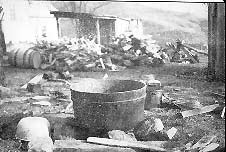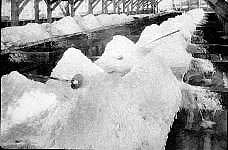
 By 1808, David and Joseph Ruffner succeeded in drilling to 59 feet, where they
secured a good flow of strong brine. Also in that year, the first salt was
shipped west, by river, on a log raft. A younger Ruffner brother, Tobias,
suspected that a vast saline reservoir existed under the Kanawha Valley and,
drilling to a depth of 410 feet, tapped an even richer brine. This discovery
set off a veritable frenzy of drilling and by 1815 there were 52 furnaces in
operation in the "Kanawha Salines." In 1817, David Ruffner experimented with
the use of coal in his furnaces, and soon all saltmakers had switched from
wood to coal. The saltmakers formed a "trust," the Kanawha Salt Company, in
order to regulate the quality and price of salt and to discourage foreign
competition. This was the first "trust" in the United States. This
cooperative helped the salt industry grow until it reached its peak in 1846,
producing 3,224,786 bushels that year. At that time, the Kanawha Valley was
one of the largest salt manufacturing centers in the United States. In 1861,
the Kanawha Valley was flooded. By the late 1800s, because of the 1861 flood
and because of Civil War destruction, the Dickinson furnace at Malden was the
only survivor of the Great Kanawha River salt industry.
Although the Kanawha salt industry declined in importance after 1861, the
advent of World War I brought a demand for chemical products such as chlorine
and caustic acid, which could be obtained from salt brine. In 1914, the
Warner-Klipstein Chemical Company opened a plant in South Charleston to
By 1808, David and Joseph Ruffner succeeded in drilling to 59 feet, where they
secured a good flow of strong brine. Also in that year, the first salt was
shipped west, by river, on a log raft. A younger Ruffner brother, Tobias,
suspected that a vast saline reservoir existed under the Kanawha Valley and,
drilling to a depth of 410 feet, tapped an even richer brine. This discovery
set off a veritable frenzy of drilling and by 1815 there were 52 furnaces in
operation in the "Kanawha Salines." In 1817, David Ruffner experimented with
the use of coal in his furnaces, and soon all saltmakers had switched from
wood to coal. The saltmakers formed a "trust," the Kanawha Salt Company, in
order to regulate the quality and price of salt and to discourage foreign
competition. This was the first "trust" in the United States. This
cooperative helped the salt industry grow until it reached its peak in 1846,
producing 3,224,786 bushels that year. At that time, the Kanawha Valley was
one of the largest salt manufacturing centers in the United States. In 1861,
the Kanawha Valley was flooded. By the late 1800s, because of the 1861 flood
and because of Civil War destruction, the Dickinson furnace at Malden was the
only survivor of the Great Kanawha River salt industry.
Although the Kanawha salt industry declined in importance after 1861, the
advent of World War I brought a demand for chemical products such as chlorine
and caustic acid, which could be obtained from salt brine. In 1914, the
Warner-Klipstein Chemical Company opened a plant in South Charleston to
 produce these products. The plant is now the Westvaco Chlorine Products
Corporation, and is the largest chlorine producer in the world. Other
chemical industries, also based on this salt brine, have grown up in the
Kanawha Valley since then.
Until World War II, only salt brine (entrapped sea water) was used for salt
production. However in 1942, the Defense Plant Corporation built an
electrolytic caustic soda plant at Natrium in Marshall County to extract
rock salt. Water is sent down the wells to the rock salt, at depths of
about 7,000 feet, where the water dissolves the salt. The salt-saturated
water is then forced back to the surface where it is evaporated and the
salt removed. Today there are three principal salt-producing companies in
the State, two in Marshall County and one in Tyler County. All three
companies extract rock salt, most of which is sent to chemical companies
along the Kanawha River. West Virginia has large reserves of rock salt
at depth, providing great potentials for future use.
(adapted from an article by Jane R. Eggleston, updated September 1996)
produce these products. The plant is now the Westvaco Chlorine Products
Corporation, and is the largest chlorine producer in the world. Other
chemical industries, also based on this salt brine, have grown up in the
Kanawha Valley since then.
Until World War II, only salt brine (entrapped sea water) was used for salt
production. However in 1942, the Defense Plant Corporation built an
electrolytic caustic soda plant at Natrium in Marshall County to extract
rock salt. Water is sent down the wells to the rock salt, at depths of
about 7,000 feet, where the water dissolves the salt. The salt-saturated
water is then forced back to the surface where it is evaporated and the
salt removed. Today there are three principal salt-producing companies in
the State, two in Marshall County and one in Tyler County. All three
companies extract rock salt, most of which is sent to chemical companies
along the Kanawha River. West Virginia has large reserves of rock salt
at depth, providing great potentials for future use.
(adapted from an article by Jane R. Eggleston, updated September 1996)
Please send questions, comments, and/or suggestions to webmaster.
Page created and maintained by:
West Virginia Geological and Economic Survey
Address: Mont Chateau Research Center
1 Mont Chateau Road
Morgantown, WV 26508-8079
Telephone: 304-594-2331
FAX: 304-594-2575
Hours: 8:00 a.m. - 5:00 p.m. EST, Monday - Friday
Permission to reproduce this material is granted if acknowledgment is given to the West Virginia Geological and Economic Survey.